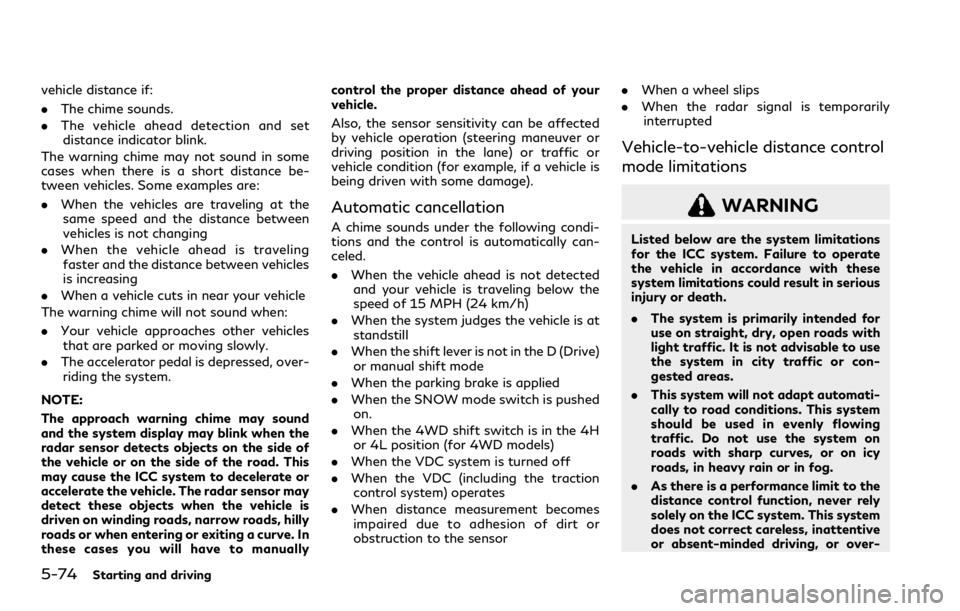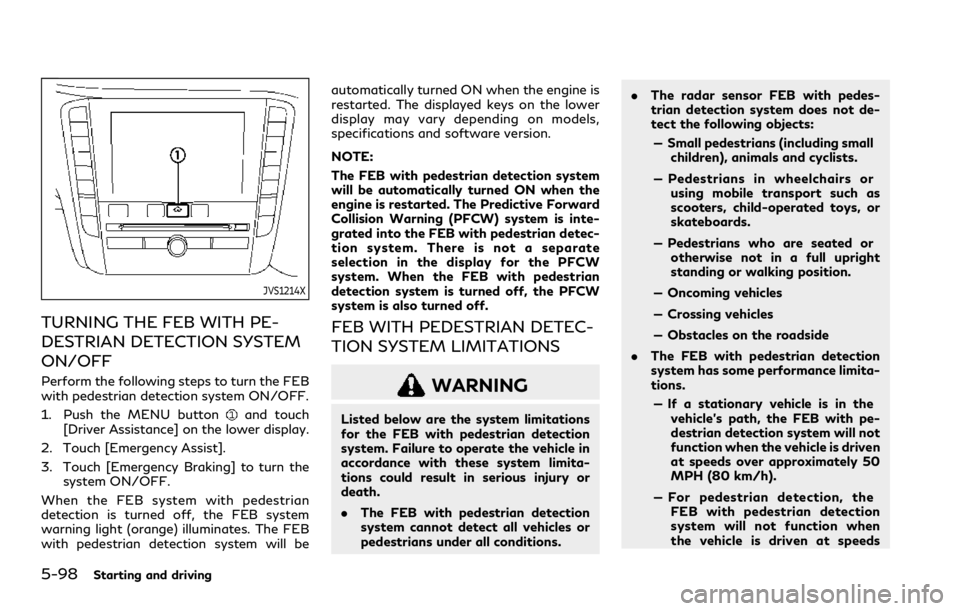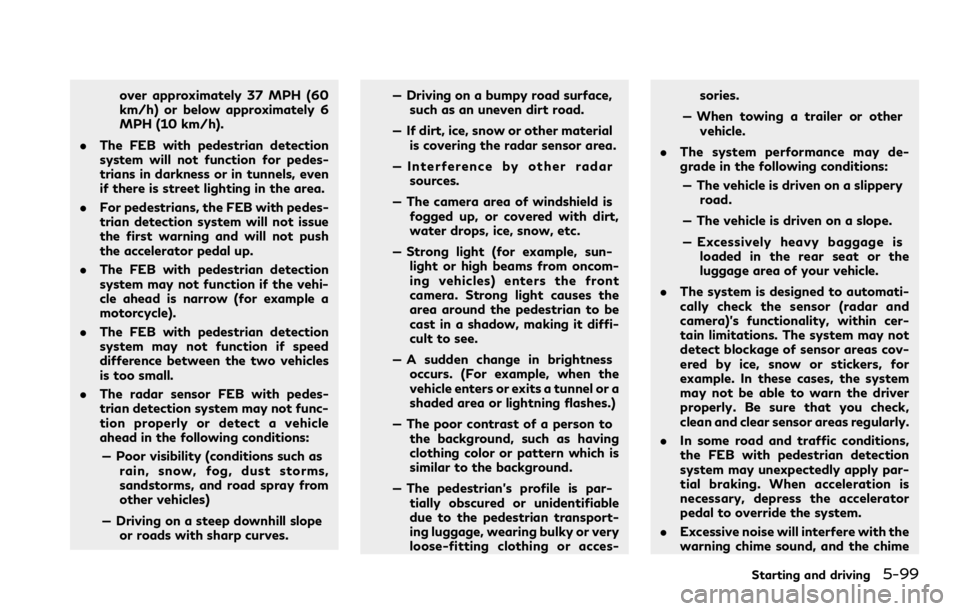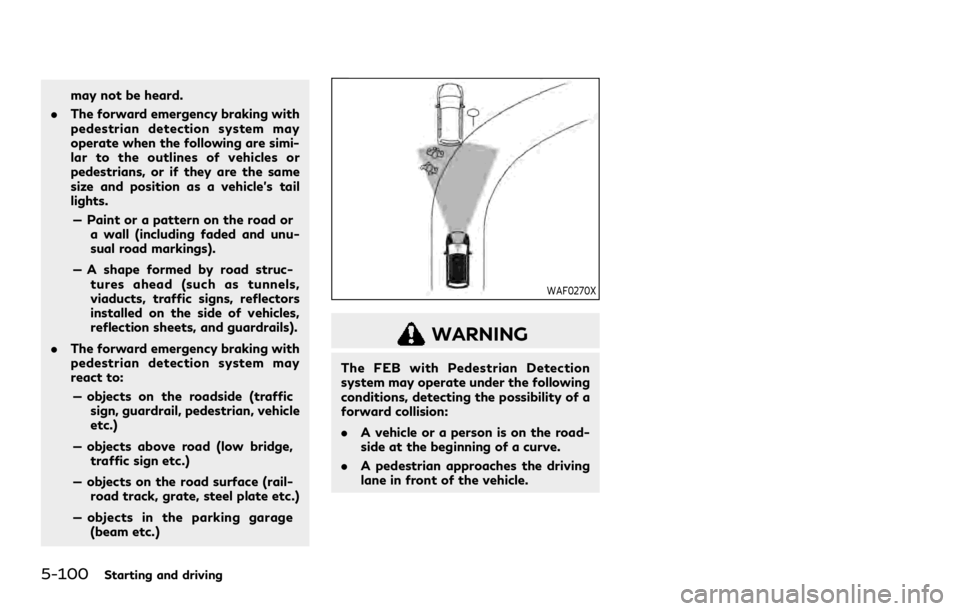warning light INFINITI QX80 2021 Manual Online
[x] Cancel search | Manufacturer: INFINITI, Model Year: 2021, Model line: QX80, Model: INFINITI QX80 2021Pages: 529, PDF Size: 2.05 MB
Page 318 of 529

WAF0300X
Side indicator light
BCI system key (on the upper display)
Lower display
JVS0173X
BCI SYSTEM OPERATION
When the shift lever is in the R (Reverse)
position and the vehicle speed is less than
approximately 5 MPH (8 km/h), the BCI
system operates.
If the radar detects a vehicle approaching
from the side or the sonar detects close
stationary objects behind the vehicle, the
system gives visual and audible warnings. If
the driver does not apply the brakes, the
system automatically applies the brake for a
moment when the vehicle is moving back-
wards. After the automatic brake applica-
tion, the driver must depress the brake pedal
to maintain brake pressure. If the driver’s
foot is on the accelerator pedal, the system
Starting and driving5-55
Page 337 of 529

5-74Starting and driving
vehicle distance if:
.The chime sounds.
. The vehicle ahead detection and set
distance indicator blink.
The warning chime may not sound in some
cases when there is a short distance be-
tween vehicles. Some examples are:
. When the vehicles are traveling at the
same speed and the distance between
vehicles is not changing
. When the vehicle ahead is traveling
faster and the distance between vehicles
is increasing
. When a vehicle cuts in near your vehicle
The warning chime will not sound when:
. Your vehicle approaches other vehicles
that are parked or moving slowly.
. The accelerator pedal is depressed, over-
riding the system.
NOTE:
The approach warning chime may sound
and the system display may blink when the
radar sensor detects objects on the side of
the vehicle or on the side of the road. This
may cause the ICC system to decelerate or
accelerate the vehicle. The radar sensor may
detect these objects when the vehicle is
driven on winding roads, narrow roads, hilly
roads or when entering or exiting a curve. In
these cases you will have to manually control the proper distance ahead of your
vehicle.
Also, the sensor sensitivity can be affected
by vehicle operation (steering maneuver or
driving position in the lane) or traffic or
vehicle condition (for example, if a vehicle is
being driven with some damage).
Automatic cancellation
A chime sounds under the following condi-
tions and the control is automatically can-
celed.
.
When the vehicle ahead is not detected
and your vehicle is traveling below the
speed of 15 MPH (24 km/h)
. When the system judges the vehicle is at
standstill
. When the shift lever is not in the D (Drive)
or manual shift mode
. When the parking brake is applied
. When the SNOW mode switch is pushed
on.
. When the 4WD shift switch is in the 4H
or 4L position (for 4WD models)
. When the VDC system is turned off
. When the VDC (including the traction
control system) operates
. When distance measurement becomes
impaired due to adhesion of dirt or
obstruction to the sensor .
When a wheel slips
. When the radar signal is temporarily
interrupted
Vehicle-to-vehicle distance control
mode limitations
WARNING
Listed below are the system limitations
for the ICC system. Failure to operate
the vehicle in accordance with these
system limitations could result in serious
injury or death.
. The system is primarily intended for
use on straight, dry, open roads with
light traffic. It is not advisable to use
the system in city traffic or con-
gested areas.
. This system will not adapt automati-
cally to road conditions. This system
should be used in evenly flowing
traffic. Do not use the system on
roads with sharp curves, or on icy
roads, in heavy rain or in fog.
. As there is a performance limit to the
distance control function, never rely
solely on the ICC system. This system
does not correct careless, inattentive
or absent-minded driving, or over-
Page 346 of 529

following methods:
1. Push the CANCEL switch. The setvehicle speed indicator will turn off.
2. Tap the brake pedal. The set vehicle speed indicator will turn off.
3. Turn the MAIN switch off. Both the cruise indicator and set vehicle speed
indicator will turn off.
To reset at a faster cruising speed, use one
of the following three methods:
1. Depress the accelerator pedal. When the
vehicle attains the desired speed, push
and release the COAST/SET switch.
2. Push and hold the ACCELERATE/RE- SUME set switch. When the vehicle
attains the speed you desire, release
the switch.
3. Push, then quickly release the ACCEL- ERATE/RESUME switch. Each time you
do this, the set speed will increase by
about 1 MPH (1.6 km/h).
To reset at a slower cruising speed, use one
of the following three methods:
1. Lightly tap the brake pedal. When the
vehicle attains the desired speed, push
the COAST/SET switch and release it.
2. Push and hold the COAST/SET switch. Release the switch when the vehicle
slows down to the desired speed. 3. Push, then quickly release the COAST/
SET switch. Each time you do this, the
set speed will decrease by about 1 MPH
(1.6 km/h).
To resume the preset speed, push and
release the ACCELERATE/RESUME
switch. The vehicle will resume the last set
cruising speed when the vehicle speed is over
25 MPH (40 km/h).
System temporarily unavailable
Under the following condition, a chime will
sound and the system control is automati-
cally canceled.
. When the vehicle slows down more than
8 MPH (13 km/h) below the set speed
. When the shift lever is shifted to the N
(Neutral) position
. When the parking brake is applied
. When the VDC (including the traction
control system) operates.
. When a wheel slips
WAF0315X
Warning light
When the system is not operating properly,
the chime sounds and the system warning
(yellow) will come on.
Action to take:
If the warning comes on, park the vehicle in a
safe place. Turn the engine off, restart the
engine, resume driving and then perform the
setting again.
If it is not possible to set or the indicator
stays on, it may indicate that the system is
malfunctioning. Although the vehicle is still
driveable under normal conditions, have the
vehicle checked. It is recommended you visit
an INFINITI retailer for this service.
Starting and driving5-83
Page 350 of 529

WAF0348X
System set display without a vehicle
ahead
System set display with a vehicle ahead
System set display with a vehicle ahead
(brake operation is necessary)
The DCA system helps assist the driver to
keep a following distance to the vehicle
ahead by braking and moving the accelera-
tor pedal upward in the normal driving
condition.
When a vehicle ahead is detected:
The vehicle ahead detection indicator (green)
comes on. When the vehicle approaches a vehicle
ahead:
.
If the driver’s foot is not on the accel-
erator pedal, the system activates the
brakes to decelerate smoothly as neces-
sary. If the vehicle ahead comes to a
stop, the vehicle decelerates to a stand-
still within the limitations of the system.
. If the driver’s foot is on the accelerator
pedal, the system moves the accelerator
pedal upward to assist the driver to
release the accelerator pedal.
When brake operation by the driver is
required:
The system alerts the driver by a warning
chime and blinking the vehicle ahead detec- tion indicator (orange). If the driver’s foot is
on the accelerator pedal after the warning,
the system moves the accelerator pedal
upward to assist the driver to switch to the
brake pedal.
NOTE:
.
The stop lights of the vehicle come on
when braking is performed by the DCA
system.
. When the brake operates, a noise may be
heard and/or vibration may be felt. This
is not a malfunction.
Overriding the system:
The following driver’s operation overrides
the system operation.
. When the driver depresses the accelera-
tor pedal even further while the system is
moving the accelerator pedal upward,
the DCA system control of the accel-
erator pedal is canceled.
. When the driver’s foot is on the accel-
erator pedal, the brake control by the
system is not operated.
. When the driver’s foot is on the brake
pedal, neither the brake control nor the
alert by the system operates.
. When the Intelligent Cruise Control (ICC)
system is set, the DCA system will be
cancelled.
Starting and driving5-87
Page 357 of 529

5-94Starting and driving
Action to take:
When the conditions listed above are no
longer present, turn the system off with the
dynamic driver assistance switch
. Turn the
DCA system back on to use the system.
. If the vehicle is parked in direct sunlight
under high temperature conditions (over
approximately 104 °F (40 °C)) and then
started, the DCA system may be deacti-
vated automatically and the “Unavail-
able: High Accelerator Temperature”
message will appear in the vehicle in-
formation display for a period of time.
Action to take:
When the interior temperature is reduced,
turn on the DCA system again.
Condition B:
Under the following conditions, making it
impossible to detect a vehicle ahead, the
DCA system is automatically canceled.
The chime will sound, the DCA system
indicator (orange) will come on and the
“Not Available: Front Radar Blocked” warn-
ing message will appear in the vehicle
information display.
. When the radar sensor area of the front
bumper is covered with dirt or is ob-
structed Action to take:
If the DCA system indicator (orange) comes
on and the warning message appears, stop
the vehicle in a safe place, place the shift
lever in the P (Park) position and turn the
engine off. When the radar signal is tem-
porarily interrupted, clean the sensor area of
the front bumper and restart the engine. If
the warning message continues to be dis-
played, have the DCA system checked. It is
recommended you visit an INFINITI retailer
for this service.
.
When driving on roads with limited road
structures or buildings (for example, long
bridges, deserts, snow fields, driving next
to long walls)
Action to take:
When the above conditions no longer exist,
turn the DCA system back on to use the
system.
SYSTEM MALFUNCTION
Condition:
When the DCA system is not operating
properly, the chime sounds and the system
warning message “Malfunction” will appear.
Action to take:
If the warning message appears, park the
vehicle in a safe place. Turn the engine off,
restart the engine, and turn on the DCA
system again.
If it is not possible to set the system or the
indicator stays on, it may indicate that the
system is malfunctioning. Although the
vehicle is still driveable under normal con-
ditions, have the vehicle checked. It is
recommended you visit an INFINITI retailer
for this service.
Page 359 of 529

5-96Starting and driving
JVS1158X
The FEB with pedestrian detection system
uses a radar sensorlocated behind the
grille of the front bumper to measure the
distance to the vehicle ahead in the same
lane.
For pedestrians, the FEB system uses a
camera
installed behind the windshield in
addition to the radar sensor.WAF0320X
Vehicle ahead detection indicator
FEB warning indicator
FEB system warning light
Page 360 of 529

FEB WITH PEDESTRIAN DETEC-
TION SYSTEM OPERATION
The FEB with pedestrian detection system
operates at speeds above approximately 3
MPH (5 km/h).
For the pedestrian detection function, the
FEB with pedestrian detection system oper-
ates at speeds between 6 – 37 MPH (10 –
60 km/h).
If a risk of a forward collision with a vehicle is
detected, the FEB with pedestrian detection
system will firstly provide the warning to the
driver by blinking the vehicle ahead detection
indicator in the vehicle information display
and providing an audible alert. In addition,
the FEB with pedestrian detection system
pushes the accelerator pedal up. If the driver
releases the accelerator pedal, then the
system applies partial braking. If the driver
applies the brakes quickly and forcefully, but
the FEB with pedestrian detection system
detects that there is still the possibility of a
forward collision, the system will automati-
cally increase the braking force.
If the risk of a forward collision becomes
imminent and the driver does not take
action, the FEB with pedestrian detection
system issues the second visual (flashing)
and audible alert, and then automatically
applies harder braking.If a risk of a forward impact with a
pedestrian is detected, the FEB with pedes-
trian detection system issues the second
visual (flashing) and audible alert , and the
system will apply partial braking. If the driver
applies the brakes quickly and forcefully but
the FEB with pedestrian detection system
detects that there is still the possibility of a
forward impact with a pedestrian, the
system will automatically increase the brak-
ing force. If the risk of collision becomes
imminent and the driver does not take
action, the FEB with pedestrian detection
system automatically applies harder braking.
NOTE:
The vehicle’s stop lights come on when
braking is performed by the FEB with
pedestrian detection system.
Depending on vehicle speed and distance to
the vehicle or pedestrian ahead, as well as
driving and roadway conditions, the system
may help the driver avoid a forward collision
or may help mitigate the consequences of a
collision should one be unavoidable.
If the driver is handling the steering wheel,
accelerating or braking, the FEB with pe-
destrian detection system will function later
or will not function.
The automatic braking will cease under the
following conditions:
.
When the steering wheel is turned as far
as necessary to avoid a collision.
. When the accelerator pedal is depressed.
. When there is no longer a vehicle or
pedestrian detected ahead.
If the FEB with pedestrian detection system
has stopped the vehicle, the vehicle will
remain at a standstill for approximately 2
seconds before the brakes are released.
Starting and driving5-97
Page 361 of 529

5-98Starting and driving
JVS1214X
TURNING THE FEB WITH PE-
DESTRIAN DETECTION SYSTEM
ON/OFF
Perform the following steps to turn the FEB
with pedestrian detection system ON/OFF.
1. Push the MENU button
and touch
[Driver Assistance] on the lower display.
2. Touch [Emergency Assist].
3. Touch [Emergency Braking] to turn the system ON/OFF.
When the FEB system with pedestrian
detection is turned off, the FEB system
warning light (orange) illuminates. The FEB
with pedestrian detection system will be automatically turned ON when the engine is
restarted. The displayed keys on the lower
display may vary depending on models,
specifications and software version.
NOTE:
The FEB with pedestrian detection system
will be automatically turned ON when the
engine is restarted. The Predictive Forward
Collision Warning (PFCW) system is inte-
grated into the FEB with pedestrian detec-
tion system. There is not a separate
selection in the display for the PFCW
system. When the FEB with pedestrian
detection system is turned off, the PFCW
system is also turned off.
FEB WITH PEDESTRIAN DETEC-
TION SYSTEM LIMITATIONS
WARNING
Listed below are the system limitations
for the FEB with pedestrian detection
system. Failure to operate the vehicle in
accordance with these system limita-
tions could result in serious injury or
death.
.
The FEB with pedestrian detection
system cannot detect all vehicles or
pedestrians under all conditions. .
The radar sensor FEB with pedes-
trian detection system does not de-
tect the following objects:
— Small pedestrians (including small children), animals and cyclists.
— Pedestrians in wheelchairs or using mobile transport such as
scooters, child-operated toys, or
skateboards.
— Pedestrians who are seated or otherwise not in a full upright
standing or walking position.
— Oncoming vehicles
— Crossing vehicles
— Obstacles on the roadside
. The FEB with pedestrian detection
system has some performance limita-
tions.
— If a stationary vehicle is in the vehicle’s path, the FEB with pe-
destrian detection system will not
function when the vehicle is driven
at speeds over approximately 50
MPH (80 km/h).
— For pedestrian detection, the FEB with pedestrian detection
system will not function when
the vehicle is driven at speeds
Page 362 of 529

over approximately 37 MPH (60
km/h) or below approximately 6
MPH (10 km/h).
. The FEB with pedestrian detection
system will not function for pedes-
trians in darkness or in tunnels, even
if there is street lighting in the area.
. For pedestrians, the FEB with pedes-
trian detection system will not issue
the first warning and will not push
the accelerator pedal up.
. The FEB with pedestrian detection
system may not function if the vehi-
cle ahead is narrow (for example a
motorcycle).
. The FEB with pedestrian detection
system may not function if speed
difference between the two vehicles
is too small.
. The radar sensor FEB with pedes-
trian detection system may not func-
tion properly or detect a vehicle
ahead in the following conditions:
— Poor visibility (conditions such as rain, snow, fog, dust storms,
sandstorms, and road spray from
other vehicles)
— Driving on a steep downhill slope or roads with sharp curves. — Driving on a bumpy road surface,
such as an uneven dirt road.
— If dirt, ice, snow or other material is covering the radar sensor area.
— Interference by other radar sources.
— The camera area of windshield is fogged up, or covered with dirt,
water drops, ice, snow, etc.
— Strong light (for example, sun- light or high beams from oncom-
ing vehicles) enters the front
camera. Strong light causes the
area around the pedestrian to be
cast in a shadow, making it diffi-
cult to see.
— A sudden change in brightness occurs. (For example, when the
vehicle enters or exits a tunnel or a
shaded area or lightning flashes.)
— The poor contrast of a person to the background, such as having
clothing color or pattern which is
similar to the background.
— The pedestrian’s profile is par- tially obscured or unidentifiable
due to the pedestrian transport-
ing luggage, wearing bulky or very
loose-fitting clothing or acces- sories.
— When towing a trailer or other vehicle.
. The system performance may de-
grade in the following conditions:
— The vehicle is driven on a slippery road.
— The vehicle is driven on a slope.
— Excessively heavy baggage is loaded in the rear seat or the
luggage area of your vehicle.
. The system is designed to automati-
cally check the sensor (radar and
camera)’s functionality, within cer-
tain limitations. The system may not
detect blockage of sensor areas cov-
ered by ice, snow or stickers, for
example. In these cases, the system
may not be able to warn the driver
properly. Be sure that you check,
clean and clear sensor areas regularly.
. In some road and traffic conditions,
the FEB with pedestrian detection
system may unexpectedly apply par-
tial braking. When acceleration is
necessary, depress the accelerator
pedal to override the system.
. Excessive noise will interfere with the
warning chime sound, and the chime
Starting and driving5-99
Page 363 of 529

5-100Starting and driving
may not be heard.
. The forward emergency braking with
pedestrian detection system may
operate when the following are simi-
lar to the outlines of vehicles or
pedestrians, or if they are the same
size and position as a vehicle’s tail
lights.
— Paint or a pattern on the road or a wall (including faded and unu-
sual road markings).
— A shape formed by road struc- tures ahead (such as tunnels,
viaducts, traffic signs, reflectors
installed on the side of vehicles,
reflection sheets, and guardrails).
. The forward emergency braking with
pedestrian detection system may
react to:
— objects on the roadside (traffic sign, guardrail, pedestrian, vehicle
etc.)
— objects above road (low bridge, traffic sign etc.)
— objects on the road surface (rail- road track, grate, steel plate etc.)
— objects in the parking garage (beam etc.)
WAF0270X
WARNING
The FEB with Pedestrian Detection
system may operate under the following
conditions, detecting the possibility of a
forward collision:
. A vehicle or a person is on the road-
side at the beginning of a curve.
. A pedestrian approaches the driving
lane in front of the vehicle.